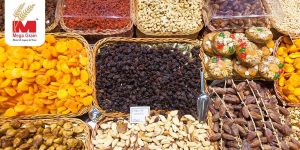 In the world of agriculture, climate plays a pivotal role in determining crop yields and quality. India, renowned for its diverse range of spices and buy bulk dry fruits in India, heavily relies on weather patterns for successful cultivation. However, with climate change leading to erratic rainfall patterns, the spice and dry fruit industry faces numerous challenges. This blog delves into the impact of uneven rainfall on spice and dry fruit production in India and explores the implications for buyers and Dry Fruits Importers.
In the world of agriculture, climate plays a pivotal role in determining crop yields and quality. India, renowned for its diverse range of spices and buy bulk dry fruits in India, heavily relies on weather patterns for successful cultivation. However, with climate change leading to erratic rainfall patterns, the spice and dry fruit industry faces numerous challenges. This blog delves into the impact of uneven rainfall on spice and dry fruit production in India and explores the implications for buyers and Dry Fruits Importers.
Climate Change and its Effects
The changing climate patterns have resulted in irregular rainfall distribution across various regions of India. Some areas experience excessive rainfall, leading to flooding and soil erosion, while others suffer from prolonged dry spells and droughts. These adverse weather conditions disrupt the natural growth cycle of spices and dry fruits, impacting their yield and overall quality.
Spice Production and Uneven Rainfall
India is renowned as the “Land of Spices,” with an abundance of aromatic and flavorful varieties. However, the uneven distribution of rainfall directly affects spice cultivation. Spices like cardamom, black pepper, and turmeric require specific moisture levels to thrive. Excessive rain can lead to waterlogging, root rot, and reduced oil content in spices, affecting their taste and aroma. On the other hand, prolonged dry periods can hamper flowering and fruiting, reducing the yield significantly.
Dry Fruit Production and Rainfall Disparities
Dry fruits, rich in nutrients and flavors, are an integral part of Indian cuisine and a popular export commodity. Almonds, cashews, raisins, and apricots are among the prominent dry fruits produced in the country. Uneven rainfall directly impacts the flowering and fruit development stages of these crops. Too much water can cause fruits to split and rot, while insufficient water hampers their growth and size. Additionally, dry conditions can also lead to pest infestations and diseases, further affecting the overall production.
Impact on Buyers and Importers
The erratic rainfall patterns can lead to fluctuations in the availability and pricing of spices and dry fruits. As the domestic production faces challenges, the demand for these commodities may surpass the supply. This scenario often leads to higher prices, making it challenging for bulk buyers and importers to maintain steady inventory and competitive pricing.
Exploring Alternatives and Solutions
Given the uncertainties arising from climate change, buyers and Dry Fruits Importers must seek viable alternatives and solutions. One approach is to diversify the sources of spice and dry fruit procurement. Collaborating with multiple suppliers from different regions can help mitigate risks associated with uneven rainfall impacts in a particular area.
Sustainable Farming Practices
Encouraging and supporting sustainable farming practices is crucial to safeguarding the spice and dry fruit industry from climate-related challenges. Implementing water management techniques, using drought-resistant varieties, and adopting eco-friendly pest control methods can enhance crop resilience and improve yield reliability.
Buy Bulk Spices Online in India
As importers seek to maintain a consistent supply of spices and dry fruits, the option to buy bulk spices online in India offers convenience and access to a myriad range of products. Reliable online platforms can connect buyers with reputable sellers and help streamline the sourcing process.
Supporting Responsible Importers
When choosing dry fruits importers, prioritizing those who follow ethical sourcing practices and adhere to quality standards is essential. Responsible Dry Fruits Importers prioritize fair trade, sustainable practices, and work closely with farmers to support their livelihoods and ensure a stable supply chain.
Significance of Dry Fruits in Festivals
Dry fruits hold immense cultural significance during various festivals in India, such as Diwali and Eid. These nutritious delights are integral to traditional festive sweets and snacks, symbolizing prosperity and sharing joy with loved ones. Their long shelf life and versatility make them ideal for gifting and offering during celebrations, enhancing the spirit of togetherness and festive cheer
Conclusion
The impact of uneven rainfall on spice and dry fruit production in India highlights the urgency of addressing climate change and adopting sustainable agricultural practices. For buyers and Dry Fruits Importers, understanding the challenges posed by erratic weather patterns is crucial in making informed decisions. Embracing responsible sourcing, diversifying supply channels, and supporting sustainable farming can lead to a more resilient and stable spice and dry fruit industry, benefiting both producers and consumers alike.
